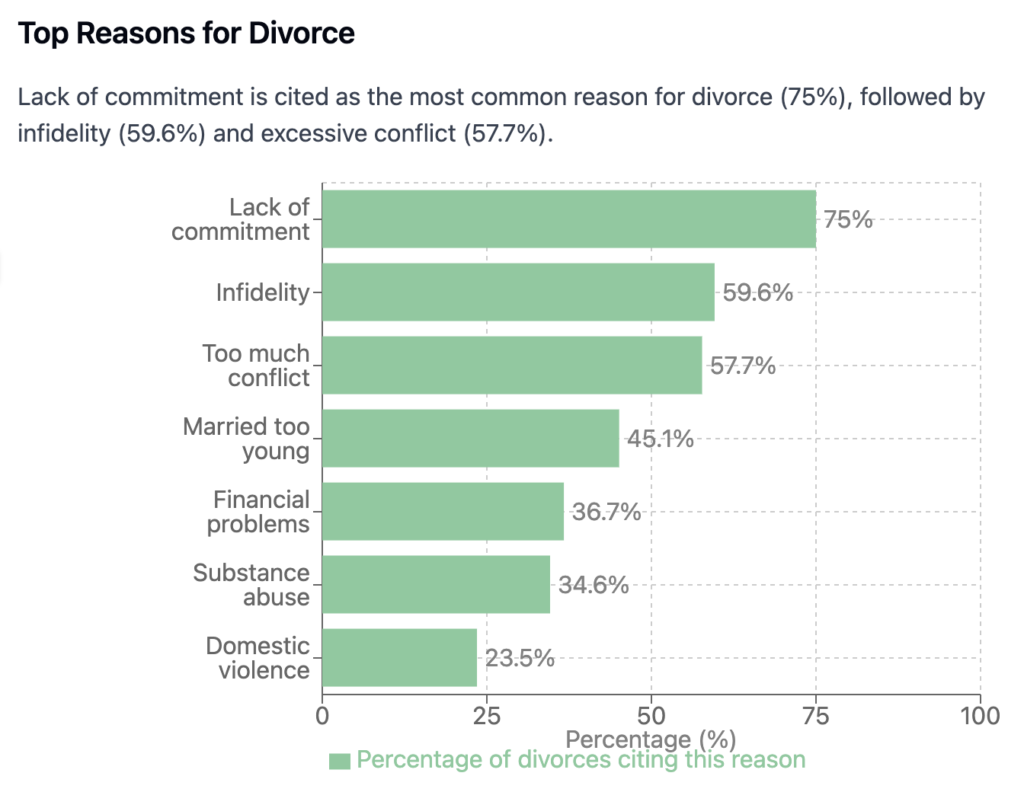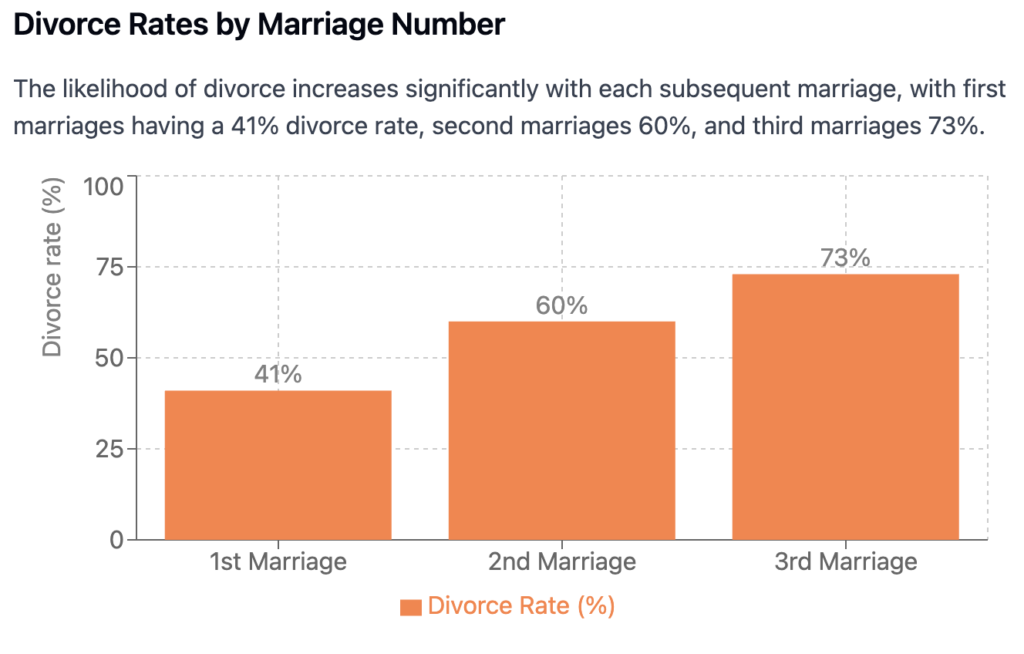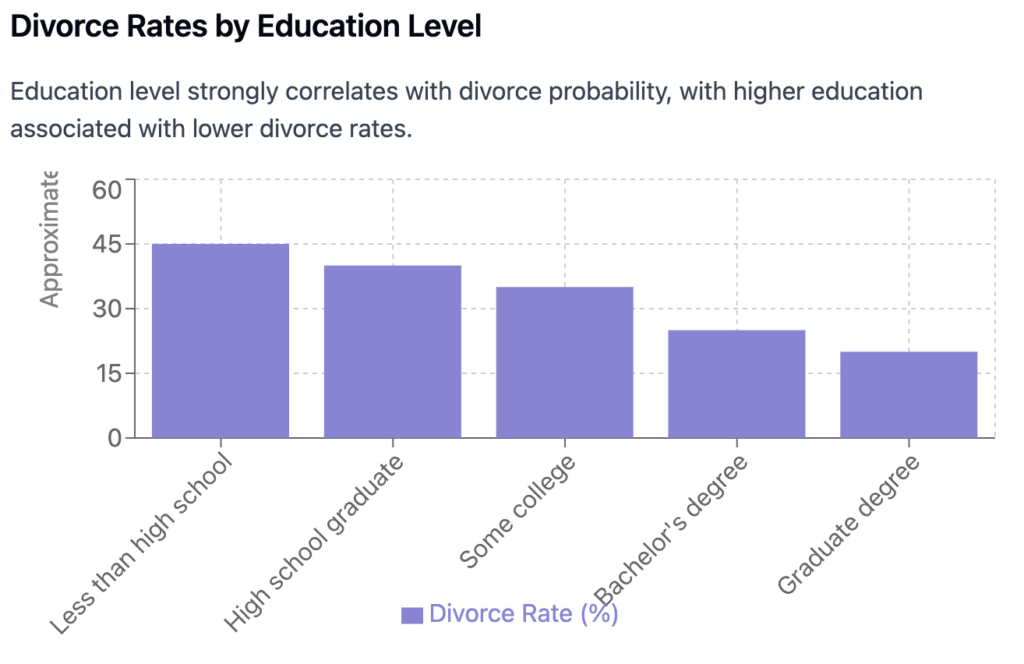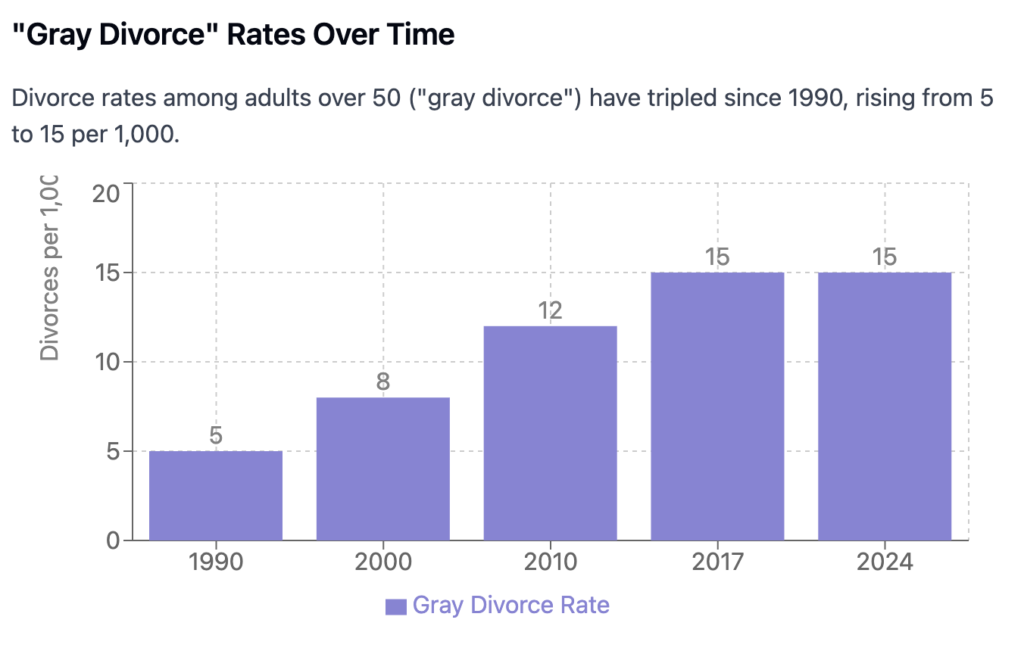Introduction
Divorce has long been a significant social phenomenon in American society, shaping families, communities, and cultural narratives. While many Americans still believe that “half of all marriages end in divorce,” the reality of divorce in the United States is far more nuanced and has been evolving significantly over the past few decades. The divorce rate has actually been steadily declining since its peak in the early 1980s, dropping from 4.0 per 1,000 people in 2000 to 2.4 per 1,000 people in 2022, marking a significant decrease over the last two decades. Divorce
This comprehensive analysis explores current divorce trends, examines the most common reasons couples separate, investigates demographic patterns, and highlights how the institution of marriage itself is changing in response to broader social and economic shifts.
Current Divorce Rates: A Declining Trend

National Trends
From 2008 to 2022, the national divorce rate in the United States declined significantly, falling from just over 10.0 to approximately 7.0 per 1,000 married women. During this same period, the national marriage rate has generally remained between 16.0 and 18.0, with the exception of 2021 when it fell below 15.0, possibly due to pandemic-related wedding postponements. Census
In 2022, there were 673,989 divorces and annulments reported across the 45 U.S. states that track this statistic, while the nation saw 2,065,905 marriages during the same year. This reflects a marriage rate of 6.2 per 1,000 people and a crude divorce rate of 2.4 per 1,000 population. Sarieh Family Law
Post-Pandemic Effects
The COVID-19 pandemic initially caused both marriage and divorce rates to drop in 2020, with the marriage rate falling to 5.1 per 1,000 people. By 2022, however, marriages rebounded to 6.2 per capita and over 2 million total marriages for the year, while divorce rates continued their long-term downward trend. CNN
According to experts, the pandemic may have influenced marriage and divorce patterns in several ways:
- Being confined together during lockdowns forced many couples to address relationship problems directly, either resolving them or confirming incompatibility CNN
- Data indicates that 20% of couples married for five months or less sought divorce during the pandemic, compared with just 11% in 2019, suggesting heightened relationship pressures during this period Sarieh Family Law
- The increasing normalization of therapy, more flexible marital roles, and greater openness about relationship expectations may have helped marriages survive the pandemic stress CNN
Common Reasons for Divorce
Understanding why marriages end provides valuable insights into the institution of marriage itself. Research has identified several consistently cited factors that contribute to divorce decisions:
Top Factors Contributing to Divorce

According to a comprehensive study of divorcing couples, the most frequently cited reasons for divorce at the individual level were lack of commitment (75.0%), infidelity (59.6%), and excessive conflict and arguing (57.7%). These were followed by marrying too young (45.1%), financial problems (36.7%), substance abuse (34.6%), and domestic violence (23.5%). Nih
Elaboration on Key Divorce Factors
- Lack of Commitment Commitment issues manifest in various ways, from gradual erosion of dedication to the relationship to dramatic drops in commitment following negative events like infidelity. As one participant in a divorce study explained, “It got to a point where it seemed like he was no longer really willing to work [on the relationship].” Nih
- Infidelity Marital infidelity remains a leading cause of divorce, with studies from the American Association for Marriage and Family Therapy indicating that approximately 25 percent of married men and 15 percent of married women have engaged in extramarital affairs. Clagett Law The American Psychological Association estimates that about 20-40% of marriages end specifically due to infidelity. Grazianolaw
- Financial Issues Studies consistently show that frequent disagreements about money are strong predictors of divorce. Financial tensions can stem from different spending habits, conflicting values regarding frugality, or divergent long-term financial goals. Clagett Law
- Communication Problems Poor communication frequently appears as both a symptom and cause of marital breakdown. Communication issues include persistent conflict over various topics, inability to resolve disagreements, and deteriorating patterns of interaction that damage the relationship over time. Pvalaw
- Substance Abuse and Addiction Substance abuse significantly increases divorce risk, with each liter of alcohol consumed raising the chance of divorce by 20%. A 9-year study by the University of Buffalo found that couples with mismatched drinking patterns—where one spouse is a heavy drinker and the other is not—are 60% more likely to divorce compared to couples with similar drinking habits. Wf-lawyers
Demographic Patterns in Divorce
Divorce rates vary significantly across different demographic groups, revealing important patterns related to age, education, income, race, and religion.
Age Factors
Age at marriage remains one of the strongest predictors of divorce risk. According to the Institute for Family Studies, people who marry before age 20 have a 32% likelihood of divorcing within the first five years, while those who marry between ages 20-24 have a 20% divorce risk. Marriages beginning at ages 25-29 have a 15% divorce rate, and those starting at 30-34 have the lowest risk at 14%. Interestingly, marriages beginning after age 35 see a slight increase in divorce risk to 19%. Divorce
The national average length of first marriages that end in divorce is approximately 8 years. Second marriages that end in divorce typically last about 7 years, while third marriages ending in divorce average around 5-8 years in duration. Memphisdivorce

Education Levels

Education significantly impacts divorce risk. High school dropouts are 13% more likely to divorce, while individuals who have attended college have a 13% lower risk of divorce. Those with “below average” IQs are 50% more likely to divorce than those with “above average” IQs. Wf-lawyers
The education gap in divorce rates has grown substantially over time, with college-educated individuals now far less likely to divorce than those with less education. According to multiple studies, people without a college degree might face a divorce rate around 45%, while those with a bachelor’s degree may see rates closer to 25%. Divorce
Income and Socioeconomic Status
Economic stability strongly influences marriage durability. Research shows that lower-income couples face more financial strains, contributing to higher divorce rates. Households earning below $25,000 annually have a significantly higher likelihood of divorce compared to more affluent couples. Sarieh Family Law
The financial consequences of divorce can be severe, particularly for women over 50, who may experience income drops of up to 45%. Higher-income households can often afford counseling and therapy to help resolve marital issues, while lower-income couples might lack access to these supportive services. Sarieh Family Law
Racial and Ethnic Patterns
Divorce rates vary significantly by race and ethnicity. African-American women have the highest divorce rate at 30.8 per 1,000, followed by Hispanic women at 18.5, white women at 15.1, and Asian women at 12.4 per 1,000. Black adults also have the highest divorce rate combined with the lowest marriage rate and tend to marry at later ages—approximately 32 for men and 31 for women. Divorce
These racial differences in marriage patterns are connected to structural economic factors. As marriage has become increasingly linked to employment and earnings, persistent economic disadvantages faced by Black Americans have contributed to growing Black-white differences in marriage rates since 1960. Nih
Religious Factors
Religious background influences divorce probability, with certain Protestant denominations (Evangelical, Historically Black, and Mainline) showing higher divorce rates at approximately 19%. Additionally, counties with higher concentrations of conservative or evangelical Protestants tend to have higher divorce rates per 1,000 married couples. Divorce
Geographic Variations
Divorce rates vary considerably across different regions of the United States, reflecting diverse cultural, economic, and policy environments.
State-Level Differences
Nevada stands out with one of the highest divorce rates in the country, while Massachusetts consistently reports among the lowest. This disparity may be partially attributed to Nevada’s reputation for having more lenient rules regarding both marriage and divorce, while Massachusetts benefits from factors like higher average ages at first marriage. Divorce
There’s also a notable political correlation, as people living in red (Republican) states are 27% more likely to get divorced than those living in blue (Democratic) states, despite conservatives individually being less likely to divorce than liberals (28% versus 37%). Wf-lawyers
The Changing Institution of Marriage
The declining divorce rate must be understood in the context of broader changes to the institution of marriage itself.
Delayed Marriage and Cohabitation
The average age of first marriage has risen significantly, reaching 28.6 for women and 30.6 for men in 2021. This trend toward later marriage often means couples have greater emotional maturity and financial stability when they wed. Sarieh Family Law
Cohabitation has become increasingly common around the world, offering couples an opportunity to test compatibility before marriage and potentially reducing future divorce risk. Our World in Data
Declining Marriage Rates
According to the U.S. Census Bureau’s 2023 America’s Families and Living Arrangements report, 56% of 18-24 year-olds and 16% of adults between 25 and 34 are living with their parents rather than getting married. Many are delaying or forgoing marriage due to financial concerns, caregiving responsibilities for aging parents, or career focus. Terry & Roberts
“Gray Divorce” Phenomenon

While overall divorce rates decline, “gray divorce” among couples over age 50 has been rising. According to the American Psychological Association, the rate has tripled since 1990, presenting unique economic and emotional challenges for partners ending decades-long relationships and navigating asset division in high-net-worth divorces. Terry & Roberts
Baby Boomers have seen their divorce rate double from 5 to 10 divorces per 1,000 since 1990, reaching 15 divorces per 1,000 by 2017. In contrast, Generation X has a rate of 18 divorces per 1,000, while Millennials have the lowest divorce rates among adult generations. Divorce
The Impact of Gender Roles and Dynamics
Gender plays a significant role in divorce patterns and proceedings.
Initiating Divorce
Women are far more likely to initiate divorce proceedings than men. Approximately 66% of divorces are filed by wives, with that figure reaching nearly 75% in some years. This gender disparity may reflect changing expectations within marriages and women’s increased economic independence. Wf-lawyers
Custody and Support
After divorce, about 90% of divorced mothers receive custody of their children. While over 79% of custodial mothers receive child support awards, only about 30% of custodial fathers receive such awards. However, more than 65% of divorced mothers receive no child support at all, highlighting significant gaps in the support system. Wf-lawyers
Emerging Trends and Future Outlook
Several emerging trends are likely to shape the future of divorce in America:
Technology and Social Media
Social media increasingly impacts relationship dynamics by creating new challenges through constant connectivity and exposure to external influences, potentially contributing to relationship stress and divorce. Sarieh Family Law A recent study found that nearly 15% of divorce petitions cited video game addiction as a major factor in the decision to divorce, while pornography addiction was cited as a factor in 56% of divorces. Wf-lawyers
Simplified Divorce Processes
Many states now offer streamlined divorce processes and equitable division of assets, potentially reducing the financial and emotional burden of ending a marriage. These procedural improvements may influence divorce rates in complex ways—making divorce more accessible while also reducing some pressures that lead to marital breakdown. LegalZoom
Pandemic Effects
The long-term effects of the COVID-19 pandemic on marriage and divorce continue to unfold. While some marriages were strengthened by facing challenges together, others revealed incompatibilities under the stress of lockdowns and economic uncertainty. CNN
Conclusion
The American divorce landscape is evolving in response to broader social, economic, and cultural shifts. While the overall divorce rate continues its decades-long decline, significant disparities persist across demographic groups, with education, income, race, and age remaining powerful predictors of marital stability.
Rather than viewing the declining divorce rate simply as evidence that marriages are becoming “better,” it may be more accurate to recognize that marriage itself is changing—becoming more selective, occurring later in life, and increasingly confined to those with educational and economic advantages. For those who do marry, expectations for relationship quality and personal fulfillment are higher than in previous generations.
Understanding these complex patterns provides valuable insights for policymakers, counselors, religious organizations, and couples themselves as they navigate the changing institution of marriage in 21st century America.

